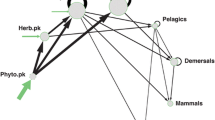Abstract
In this paper we discuss the basic principles of discrete event, individual oriented, data based modelling in ecology, and we present an application of this modelling strategy. The strategy is contrasted with some more conventional modelling strategies with respect to its purpose, its basic units and its heuristic properties.
INSTAR applies this modelling strategy to the simulation of the fluctuations of the population structure and density of microcrustaceans through the year. The model encompasses one microcrustacean species at a time, and its interface with the rest of the ecosystem; it has been applied to several Cladocera and Copepoda species in a shallow eutrophic lake in the Netherlands (Vijverberg & Richter 1982a, b). Possibilities for extending the model are discussed.
Similar content being viewed by others
References
Argentesi, F. R., Bernardi, R. de & Di Cola, G., 1974. Mathematical models for the analysis of population dynamics in species with continuous recruitment. Mem. Ist. ital. Idrobiol. 31: 245–275.
Bernardi, R. de, 1974. The dynamics of a population of Daphnia hyalina Leydig in Lago Maggiore, Northern Italy. Mem. Ist. ital. Idrobiol. 31: 221–243.
Bernardi, R. de & Di Cola, G., 1976. Instantaneous growth rates and production in natural zooplankton populations. Mem. Ist. ital. Idrobiol. 33: 105–123.
Bottrell, H. H., 1975a. Generation time, length of life, instar duration and frequency of moulting, and their relation to temperature in eight species of Cladocera from the River Thames, Reading. Oecologia 19: 129–140.
Bottrell, H. H., 1975b. The relationship between temperature and duration of egg-development in some epiphytic Cladocera and Copepoda from the River Thames, Reading, with a discussion of temperature functions. Oecologia 18: 63–84.
Dahl, O. J., Myhrhaug, B. & Nygaard, K., 1970. Simula information common base language. Norwegian Computing Center, Publ. No. S.22
Dussart, B., 1969. Les Copépodes des eaux continentales d'Europe occidentale, Tome 2: Cyclopoides et biologic. Boubée, Paris. 292 pp.
Hogeweg, P., 1974. Concept for simulation, a comparison based on simulation languages. In: Buffort, H. F. J. M. & J. H. L. (Eds.) Developments in Systems Theory, Vol. 1, pp. 119–135. Stenfert Kroese, Leiden.
Hogeweg, P. & Hesper, B., 1978. Interactive instruction on population interactions. Comput. Biol. Med. 8: 319–327.
Hogeweg, P. & Hesper, B., 1979. Heterarchical selfstructuring simulation systems, concept and applications in biology. In: Zeigler, B. P. (Ed.) Methodologies of Modelling & Simulation, pp. 221–231. North-Holland.
Hogeweg, P. & Hesper, B., 1981a. Two predators and a prey in a patchy environment; an application of MICMAC modelling. J. theor. Biol. 93: 311–332.
Hogeweg, P. & Hesper, B., 1981b. On the role of OBSERVERS in large scale systems. In: Proc. of the UKSC/81 Conf. on Computer Simulation, Harrogate, England, pp. 420–425. Westbury House.
Hogeweg. P. & Hesper, B., 1981c. Selfstructuring simulation systems. In: Ören, T. (Ed.) Proc. Cybersoff Symposium, Namur (Belgium).
Lotka, A. J., 1925. Elements of Physical Biology. Williams & Wilkins, Baltimore.
Miller, C. B., Johnson, J. K. & Heinle, D. R., 1977. Growth rules in the marine copepod genus Acartia. Limnol. Oceanogr. 22: 326–335.
Mac Mahon, J. A., Schimpf, D. J., Andersen, D. C., Smith, K. G. & Bayn, R. L., Jr., 1981. An organism centered approach to some community and ecosystem concepts. J. theor. Biol. 88: 287–308.
Nicholson, A. J., 1933. The balance of animal population. J. Anim. Ecol. 2: 132–178.
Volterra, V., 1926. Variazione e fluttuazioni del numero d'individui in specie animali canviventi Mem. Accad. Nazi. Lincci 2: 31–113 (transt. in Chapman, R. N., 1931, Animal Ecology, McGraw Hill, New York).
Vijverberg, J., 1976. The effect of food quantity and quality on the growth, birth rate and longevity of Daphnia hyalina Leydig. Hydrobiologia 51: 99–109.
Vijverberg, J., 1980. Effect of temperature on laboratory studies on development and growth of Cladocera and Copepoda from Tjeukemeer, The Netherlands. Freshwat. Biol. 10: 317–340.
Vijverberg, J. & Richter, A. F., 1982a. Population dynamics and production of Daphnia hyalina Leydig and Daphnia cucullata Sars in Tjeukemeer. Hydrobiologia 95: 235–259.
Vijverberg, J. & Richter, A. F., 1982b. Population dynamics and production of Acanthocyclops robustus (Sars) and Mesocyclops leuckarti (Claus) in Tjeukemeer. Hydrobiologia 95: 261–274.
Zeigler, B. P., 1976. Theory of Modelling & Simulation. John Wiley, New York.
Zeigler, B. P., 1978. Multi-model, multi-formalism modelling; an ecosystem example. In: Halfon, E. (Ed,) Theoretical Ecosystems. Academic Press.
Author information
Authors and Affiliations
Rights and permissions
About this article
Cite this article
Hogeweg, P., Richter, A.F. INSTAR, a discrete event model for simulating zooplankton population dynamics. Hydrobiologia 95, 275–285 (1982). https://doi.org/10.1007/BF00044489
Issue Date:
DOI: https://doi.org/10.1007/BF00044489




